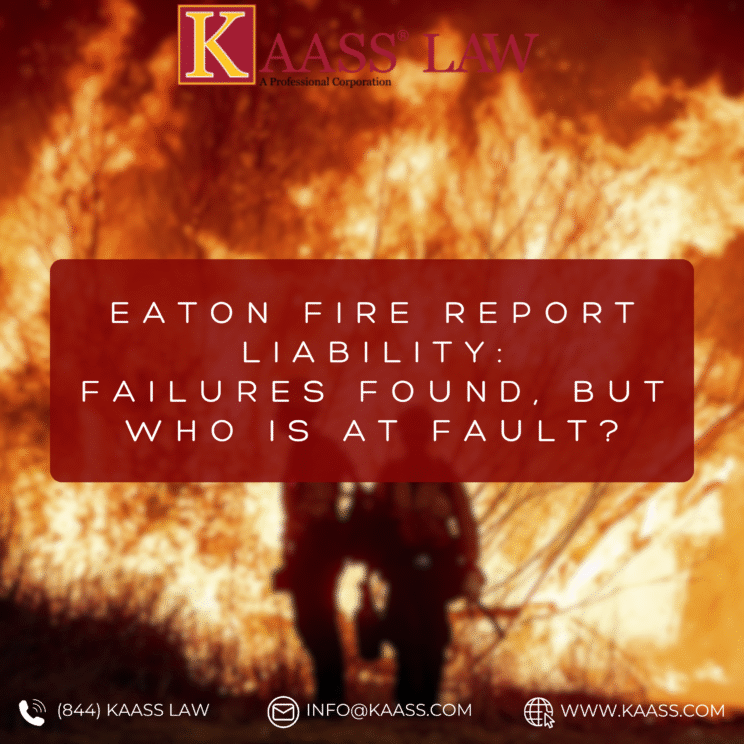Months after the devastating Eaton Fire swept through Altadena and surrounding communities, Los Angeles County has released its long-awaited after-action report. For the thousands of residents who lost homes and the families of the 19 people who died, the report provides some answers. However, it also raises difficult questions. According to news analysis from the Los Angeles Times, the report details numerous systemic failures but stops short of assigning blame to any single person or agency. This “no smoking gun” conclusion leaves many victims wondering: if there were failures, who has legal liability?
This article will break down the key findings of the official report. More importantly, we will explore what these findings mean for Eaton Fire Report Liability claims. We will also explain how a report that identifies systemic flaws can still be a powerful tool for victims seeking justice.
What the Report Found: A Pattern of Systemic Failures
The LA County Board of Supervisors commissioned an independent after-action review. The McChrystal Group conducted this review to provide a comprehensive look at the emergency response. The official report, released by Los Angeles County, found that while first responders acted heroically, the county’s overall effort was hampered by a “series of weaknesses.”
The report identified several critical failures. These include:
- Outdated and Unclear Policies: The report found practices for issuing emergency alerts and evacuation orders to be “outdated, unclear and contradictory.”
- Delayed Alerts: The report confirmed a significant, hours-long delay. This delay occurred between when fire commanders in the field recommended evacuations and when the county actually sent the official alerts to residents.
- Communication Gaps: First responders from different agencies struggled to share information in real-time. This was due to a variety of unconnected communication platforms.
- Staffing and Resource Shortages: The report highlighted that key agencies, including the Sheriff’s Department and the Office of Emergency Management, were understaffed. This hindered the response.
Crucially, the report concluded there was “no single point of failure.” Instead, it attributed the tragic outcome to these numerous, overlapping systemic issues.
The Gap Between a “No Smoking Gun” Report and Legal Liability
While the report’s refusal to “name names” is frustrating for many, it does not mean that no one has legal liability. In a civil lawsuit, the goal is not always to find a single “smoking gun.” The goal is to demonstrate that a party’s negligence—or failure to use reasonable care—was a substantial cause of the harm.
A government report that officially documents systemic failures is an incredibly powerful piece of evidence. An attorney can use it to show that a government entity, like a county or city, knew or should have known that its emergency systems were flawed. This helps establish foreseeability, a key element in proving negligence.
How the Eaton Fire Report Impacts Liability Claims
This official report can be the foundation of a strong legal claim for victims. An experienced attorney can use the report’s findings to argue that:
- The County Breached Its Duty of Care: By operating with “outdated” policies and known communication gaps, the county failed in its duty to have a reasonably competent emergency response system.
- Failures Caused Harm: The report’s confirmation of delayed evacuation alerts can be directly linked to injuries and deaths. For example, a family that received an alert hours late, or not at all, has a powerful argument that this specific failure contributed to their tragedy.
While the government has immunity for many of its policy-making decisions, that immunity is not absolute. It generally does not protect a public entity from liability for failing to carry out its own mandatory safety duties.
Other Potential Liable Parties
Beyond the government’s response, the initial cause of the fire is still under investigation. A thorough legal analysis of Eaton Fire Report Liability must also consider other potential defendants. In many California wildfires, investigators trace the ultimate cause back to the negligence of a utility company. If an investigation reveals that faulty power lines or poorly maintained equipment sparked the Eaton Fire, the utility could be held liable for all the resulting damages.
How KAASS LAW Can Help
The aftermath of a catastrophic wildfire is overwhelming. Navigating a complex legal claim, especially one involving a government entity, requires deep experience and resources. At KAASS LAW, our attorneys specialize in holding negligent parties accountable after devastating events.
Our Personal Injury team understands how to use official reports and independent investigations to build a powerful case. We work with experts to prove how systemic failures or corporate negligence led to our clients’ losses. We also have a deep understanding of the strict procedures and short deadlines for filing claims against government entities in California. If you have suffered losses from the Eaton Fire, please Contact Us for a free, confidential consultation.
Conclusion
The official report on the Eaton Fire confirms what many survivors already knew. Systemic failures in communication and evacuation procedures hampered the response to this deadly blaze. While the report may not name a single individual to blame, its findings provide a critical foundation for victims seeking justice. The issue of Eaton Fire Report Liability is far from over. For the families and homeowners affected by this tragedy, this report is a key piece of evidence in the fight to hold the responsible parties accountable.

